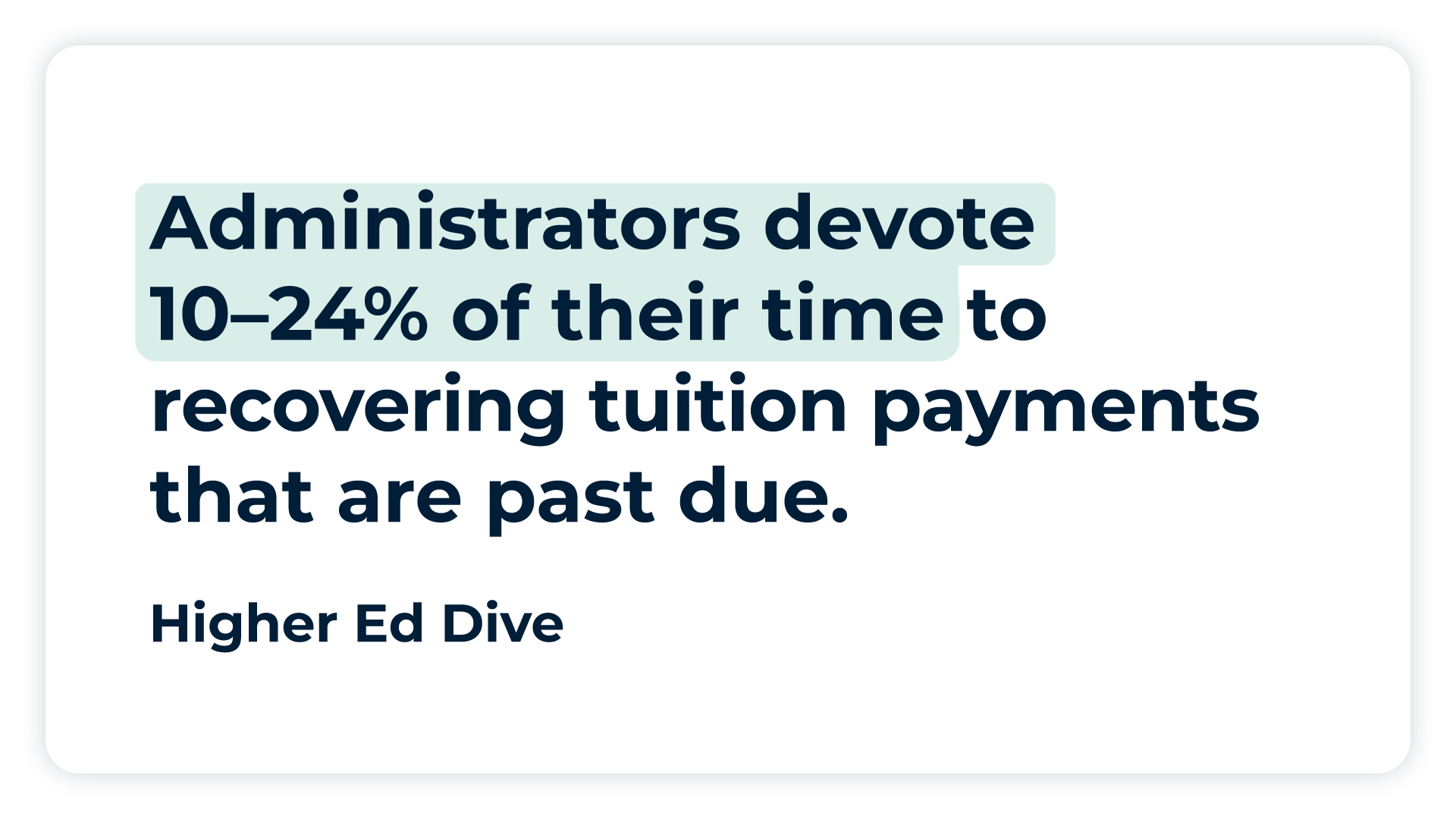Managing tuition and fee recovery is a challenge for universities worldwide, particularly when working with international students.
Beyond the inherent administrative burden, late tuition payments disrupt cash flow, delay service access, and strain staff resources. However, with well-designed automation strategies, institutions can significantly reduce late payments, maintain operational stability, and enhance the student experience.
The damaging effect of late tuition payments
Manual reminder systems can be inefficient, error-prone, and inconsistent. According to a recent survey, administrators devote 10–24% of their time to recovering tuition payments that are past due, a bottleneck that undermines both institutional health and student retention.
Moreover, late fees can add up substantially and create a major burden for both students and universities.
About 70% of institutions manage past-due tuition and fees exceeding $1 million, with many handling portfolios of more than $5 million, the Higher Ed Dive survey found.
Recouping these funds on time can enable universities to improve student experiences and invest in new faculty and academic programs.

Automating student payment reminders is key
Automating student payment reminders is the simplest solution to the challenge. Accounts receivable teams at educational institutions can accelerate cross-border payment timelines by sending emails, SMS, or WhatsApp messages to international students before and after due dates.
By automating such communications, administrators can be more effective, freeing resources to focus on higher-value tasks related to education rather than chasing payments.
Such process improvements also boost student satisfaction, especially among international students managing varying time zones, currencies, and communication preferences.
Designing a smarter receivables strategy
When choosing an automation platform, educational institutions should ensure it supports reminders via email, SMS, WhatsApp, or push notifications, whichever best fits their student habits. The tone of these messages can be customized by demographic or region, starting friendly and becoming firmer over time, while avoiding harsh language.
To incentivize early payments, universities can offer small discounts to improve compliance without damaging goodwill.
The timing of the reminders should revolve around the academic calendar, registration deadlines, and/or semester start dates. Custom schedules that match diverse programs or international timelines ensure relevance across global audiences.
Operationally, a dashboard that offers real-time visibility into outstanding dues, reminder performance, and student engagement simplifies the management of these efforts without the need for spreadsheets or reactive workflows.
To ensure student data, invoices, and reminder triggers stay synchronized, it’s best to integrate the dashboard with Student Information Systems (SIS), Learning Management Systems (LMS), Customer Relationship Management (CRM) platforms, and payment gateways.
Dealing with past-due tuition the smart way
For international educational institutions, automation ensures that payments are timely, staff operate efficiently, and students feel supported. Automating reminders with thoughtful timing, incentives, and multichannel outreach is a responsive and respectful solution that takes students’ realities into account.
The best place for university administrators to begin is identifying key student segments (e.g., international vs. domestic, full-time vs. part-time) and understanding their payment behaviors, time zones, and language preferences.
Universities must also determine the most effective mix of communication channels. An email, for example, can be used for formal communication, SMS or WhatsApp for immediacy, and web portals for clarity. The key is to remain flexible and allow students to select the methods that work for them. By catering to each student’s communication preferences, universities can ensure their messages about outstanding tuition resonate more deeply.
Then, administrators can establish an automated reminder workflow:
- Students receive pre-due-date reminders 2–3 weeks ahead, and a final reminder a few days before the deadline.
- If the payment isn’t received, an immediate follow-up is triggered.
- It’s worth including incentive messaging, such as early payment rewards and late-fee notices.
Once the communications are deployed, accounts receivable teams can track open rates, click-throughs, payments triggered, and overdue rates. These insights can be used to adjust the timing, frequency, or tone of reminders.
Improving university cash management, together
Effectively managing cross-border tuition payments should also include:
- Currency management: Supporting multi-currency orders and displaying FX rates.
- Time zone sensitivity: Respecting local habits when scheduling reminders.
- Localization: Translating reminder language and providing multilingual support for added clarity.
- Compliance: Ensuring communication and data practices align with regional and local privacy laws and regulations.
In particular, Convera’s growing partnership with IODM can help educational institutions in the UK, Japan, and the US streamline accounts receivable from international students and facilitate cross-border payments.
At no additional cost, institutions can deploy the joint solution from Convera and IODM to strengthen cash availability, improve tuition collection outcomes, shift from reactive debt recovery to proactive strategies, and offer flexible payment options to improve the student payment experience.
Adopting a comprehensive international payments solution is more than an improvement to bursars’ processes — it’s a commitment to effective communication, better student outcomes, and smoother operations for institutions with global reach.



